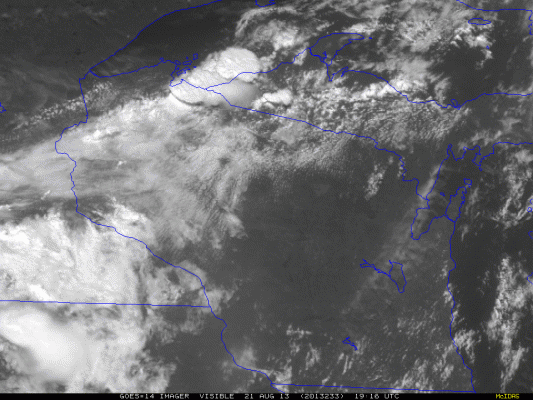Experts convene in Madison to explore forecasting advances
Every year, severe storms endanger lives and cause extensive property damage. The National Weather Service’s Storm Prediction Center reported 1847 tornadoes in 2012 and 2013 combined resulting in 125 tornado-related deaths. The National Climatic Data Center reported six severe storms across the United States in 2013 with losses in excess of $1 billion each.
Pooling their collective knowledge, more than 300 experts, primarily from universities and government laboratories, gathered in Madison this week to discuss operational and research advances in understanding and predicting these storms.
The 27th Conference on Severe Local Storms of the American Meteorological Society features presentations across the full range of severe convective weather from tornado prediction and dynamics, modeling studies, and climatologies to radar observations of large hail, debris, and downbursts, advances in numerical weather prediction, and data assimilation.
Given the proximity to UW-Madison’s Space Science and Engineering Center (SSEC) and the Cooperative Institute for Meteorological Satellite Studies (CIMSS) – known for their expertise in satellite remote sensing – the conference also highlighted ongoing research using satellite observations to augment other methods of severe weather prediction, including a session focused on GOES-R — first in the next generation of geostationary satellites — and its capabilities.
According to CIMSS scientist Wayne Feltz, satellite sessions at the severe local storms conferences have been growing particularly due to the anticipated launches of GOES-R in 2016 and the Joint Polar Satellite System (JPSS) in 2017, the next generation polar-orbiting operational environmental satellite system. Satellites are offering important coverage for monitoring severe weather “because the resolution of satellite data is now useful for the mesoscale,” he says.
Feltz explains, “Satellite technology has evolved temporally, spatially, and spectrally so it can augment traditional technologies, like radar, for the local scale. We’re now getting rapid scan imagery at five-minute intervals, providing more and better quantitative information about the probability of severe weather.”
These technologies, in combination with current forecasting tools such as radar, are aiding the prediction of hazardous weather.
Many SSEC and CIMSS scientists and students contributed satellite-related talks. They included:
- Using a blog to tell short, compelling stories based on satellite observations (Scott Lindstrom and Scott Bachmeier);
- Supporting Global Hawk hurricane missions with satellite products (Sarah Griffin and Chris Velden);
- Flood spatiotemporal decision-making and community response actions (Shane Hubbard);
- Exploiting satellite data to increase lead-time of severe weather warnings (Mike Pavolonis (NOAA/NESDIS), John Cintineo, and Justin Sieglaff);
- Mesoscale observations with GOES-14 SRSOR (Tim Schmit, Mat Gunshor, Justin Sieglaff, Scott Bachmeier, Scott Lindstrom, Chad Gravelle, and Kaba Bah);
- Advanced infrared sounder cloud detection (Pei Wang, Jun Li, Jinlong Li, Tim Schmit, and Zhenglong Li);
- NOAA/CIMSS Prob Severe model (Justin Sieglaff, Mike Pavolonis, and John Cintineo);
- GOES-R demonstration products and severe weather watches (Chad Gravelle, Ralph Petersen, and Junstin Sieglaff);
- Assimilation of satellite and radar observations (Rebecca Cintineo and Jason Otkin);
- Communicating information on evolving convective available potential energy using satellite sounders (Jessica Gartzke and Robert Knuteson);
- Extreme precipitable water events and societal implications (Jacola Roman, Robert Knuteson, Steve Ackerman, and Hank Revercomb);
- Identifying transverse banding and gravity waves by satellite (Anthony Wimmers. Chris Scheele, and Wayne Feltz); and
- Analysis of convective clouds viewed from GOES during DC3 (Andrew Heidinger, Steve Wanzong, and Andi Walther).
Beyond the immediate concerns of forecasting severe weather, researchers are analyzing our changing climate to try to predict how it will affect future storms. Further, the forecasting and research communities are actively engaged in discussions, across disciplines, to more effectively communicate weather hazards and risks to the public.
The 27th Conference on Severe Local Storms concludes on Friday, November 7th.

